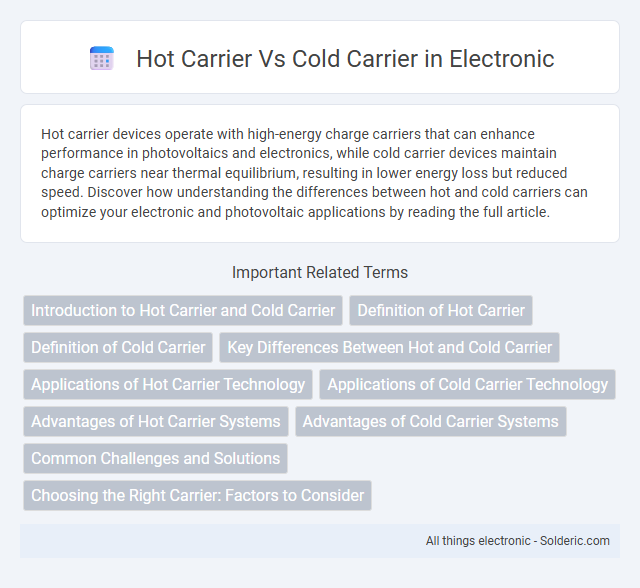Hot carrier devices operate with high-energy charge carriers that can enhance performance in photovoltaics and electronics, while cold carrier devices maintain charge carriers near thermal equilibrium, resulting in lower energy loss but reduced speed. Discover how understanding the differences between hot and cold carriers can optimize your electronic and photovoltaic applications by reading the full article.
Comparison Table
| Feature | Hot Carrier | Cold Carrier |
|---|---|---|
| Definition | Charge carriers with high kinetic energy surpassing thermal equilibrium | Charge carriers at thermal equilibrium with the lattice temperature |
| Energy Level | Excess energy above the conduction or valence band edge | Energy close to the band edge at thermal energy levels |
| Temperature | Effective temperature higher than the lattice temperature | Effective temperature equal to the lattice temperature |
| Origin | Generated by high electric fields, optical excitation, or impact ionization | Thermally generated under equilibrium conditions |
| Transport | Non-equilibrium transport, may cause velocity saturation or negative differential resistance | Equilibrium transport governed by standard scattering mechanisms |
| Applications | Used in hot-carrier solar cells, high-speed transistors, and impact ionization devices | Relevant in conventional semiconductor devices operating near equilibrium |
| Impact on Device Performance | Can improve efficiency but may cause overheating and reliability issues | Stable performance with predictable thermal characteristics |
Introduction to Hot Carrier and Cold Carrier
Hot carriers are charge carriers, such as electrons or holes, that possess higher energy than the thermal equilibrium state due to external excitation, leading to non-equilibrium transport behaviors. Cold carriers, on the other hand, are charge carriers at or near thermal equilibrium, exhibiting lower kinetic energy and standard transport characteristics. Understanding the differences between hot and cold carriers is essential for optimizing the efficiency of semiconductor devices and enhancing your electronic system's performance.
Definition of Hot Carrier
A hot carrier is an electron or hole in a semiconductor that possesses significantly higher kinetic energy than the thermal equilibrium state, often generated by photon absorption or high electric fields. These energetic carriers can traverse the material before losing energy through collisions, influencing device performance and enabling applications like hot carrier solar cells. Unlike cold carriers, which remain near thermal equilibrium, hot carriers exhibit non-equilibrium dynamics critical for advanced optoelectronic technologies.
Definition of Cold Carrier
Cold carriers refer to charge carriers in a semiconductor or conductor that have thermal energy close to the lattice temperature, meaning they do not possess excess kinetic energy beyond equilibrium conditions. Unlike hot carriers, which have elevated energy levels due to external excitation like high electric fields or light absorption, cold carriers exhibit energy distributions governed primarily by the ambient temperature. This distinction critically impacts device performance in electronics and optoelectronics, influencing phenomena such as carrier mobility, recombination rates, and noise characteristics.
Key Differences Between Hot and Cold Carrier
Hot carriers possess higher kinetic energy and move rapidly due to increased thermal excitation, while cold carriers have lower energy and slower movement in a semiconductor. The key differences lie in energy distribution, with hot carriers contributing to non-equilibrium processes and cold carriers maintaining near-equilibrium states essential for stable device operation. Understanding these distinctions helps optimize Your semiconductor device performance by managing carrier energy for efficiency and reliability.
Applications of Hot Carrier Technology
Hot carrier technology is revolutionizing solar cells and photodetectors by enabling higher energy conversion efficiencies through the capture of high-energy charge carriers before they thermalize. This technology enhances the performance of next-generation optoelectronic devices, allowing your systems to harvest more electrical power from the same amount of sunlight. Advanced applications include ultra-fast transistors and photovoltaic cells designed for superior energy harvesting in both consumer electronics and industrial solar energy solutions.
Applications of Cold Carrier Technology
Cold carrier technology is widely applied in advanced semiconductor devices and optoelectronics to enhance energy efficiency and performance. It enables precise control of electron flow at low temperatures, improving the operation of high-speed transistors, photodetectors, and quantum computing components. Your industry benefits from cold carrier techniques by achieving lower power consumption and increased device longevity in communication systems and nanoscale electronics.
Advantages of Hot Carrier Systems
Hot carrier systems enhance photovoltaic efficiency by utilizing high-energy charge carriers before they lose excess energy through thermalization, resulting in greater power conversion efficiency compared to cold carrier systems. These systems can potentially capture a broader spectrum of solar energy by extracting carriers at elevated energies, thus reducing energy loss and improving overall device performance. The improved hot carrier collection minimizes heat dissipation and optimizes the charge extraction process, leading to more efficient solar cells and thermoelectric devices.
Advantages of Cold Carrier Systems
Cold carrier systems offer significant advantages including reduced thermal damage to sensitive components and enhanced system reliability by maintaining lower operating temperatures. These systems improve energy efficiency and prolong the lifespan of electronic devices by minimizing heat-induced stress. Your equipment benefits from increased performance stability and decreased maintenance costs with cold carrier technology.
Common Challenges and Solutions
Hot carrier and cold carrier technologies face common challenges such as signal degradation, interference, and thermal management inefficiencies. Optimizing receiver sensitivity and employing advanced error correction algorithms enhance data integrity, while using adaptive modulation and robust cooling systems mitigates interference and overheating issues. Your choice between hot and cold carriers should factor in the specific application requirements and environmental conditions to implement the most effective solutions.
Choosing the Right Carrier: Factors to Consider
Choosing the right carrier involves evaluating factors such as service area coverage, delivery speed, and cost efficiency tailored to your business needs. Hot carriers prioritize expedited shipping and temperature-controlled environments, ideal for perishable goods or urgent deliveries, while cold carriers specialize in maintaining low temperatures for sensitive items like pharmaceuticals and food products. Your decision should balance product requirements, budget constraints, and customer expectations to optimize supply chain reliability.
Hot carrier vs Cold carrier Infographic

 solderic.com
solderic.com